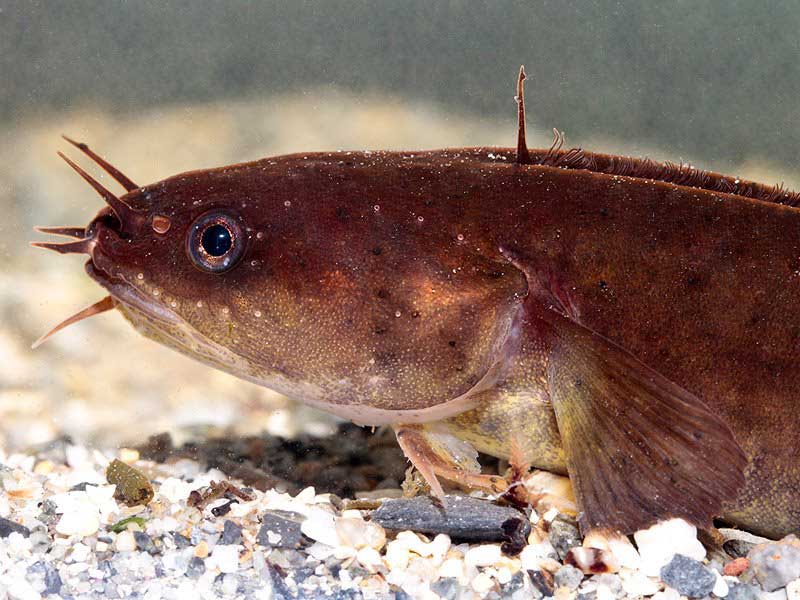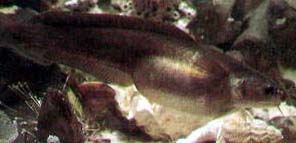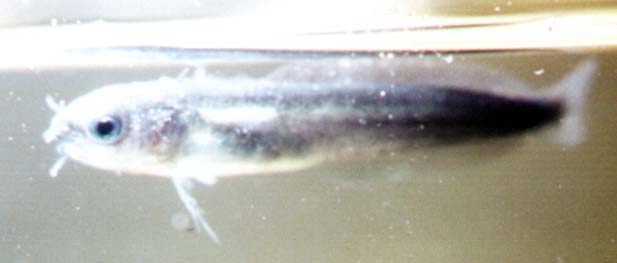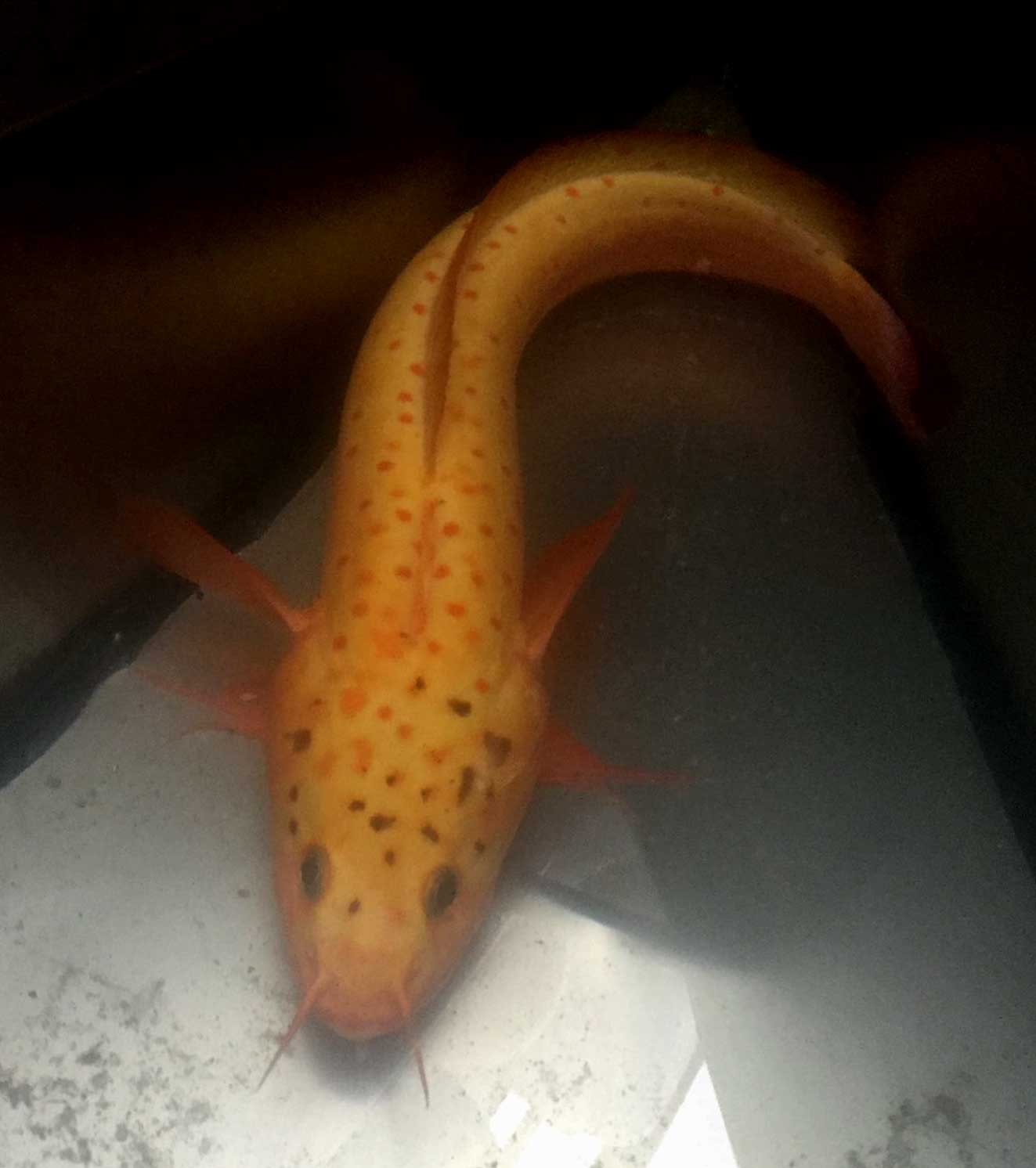Identification:

Photograph
by Andy
G Rapson
A small brown elongate
fish with five barbels on the head and an unusual first dorsal fin which
consists of a single first ray followed by a fringe of vibrating rays set
in a trench-like depression. There is no fin membrane between the rays
in the first dorsal arrangement, but the second dorsal fin is conventional
and runs the length of the body
Similar Species
Breeding:
Spring
 Ovigerous fish
Ovigerous fish
Habitat:
In shallow water usually
over sand, and intertidal under rocks. In very rocky areas the similar
species Gaidropsarus mediterraneus can
be found
Food:
Small crustaceans and worms.
Range:
All British coasts, Atlantic
coasts of Norway, Iceland, France and Spain, North Sea.
Additional
Notes:
Count the barbels to be
sure of identification. Young are silver and live in the surface water,
until summer when they descend to the sea floor inshore and change colour
to brown. A fish sensitive to low oxygen conditions.

Juvenile Rockling swim in the surface waters
Reports of rocklings can be
sent to:
Shorewatch
Project EMail
Glaucus@hotmail.com.
Reports:
Abundant off Bridlington
Pier John Hopkin.
Recorded
near Sully, near Cardiff, south Wales,
Spring
2000 Peter
Barfoot
Caught
a specimen off the back of my boat moored in Ramsgate harbour, November
2000, Kent using a lugworm bait, about 25
cm long. Maurice
Walsh
I
would like to report the capture and release of a rockling (number of beards
unknown) on Sunday 11th Feb 2001
just after high water pm on New Brighton promenade, Lancashire, at the
bottom of Vaughan Road.
It
was approx 15-20cm long and fell to a bait of farm ragworm. John
Curphey
I found three 5 Bearded
Rocklings (under rocks) on Southsea beach (Hants.) at a very low tide (9
Feb. 2001). One was - I think - pregnant; one was fully grown
and one was a yearling. The latter I have kept and it is 'doing well'
in my aquarium.
Whilst
shore fishing I caught four 5-Bearded rocklings at Beesands, South Devon
today (13/4/01).
Their
size ranged from 8-12 cm, all returned alive. Simon
Nobbs.
November
2001. Single 5 Bearded Rockling (20 cm) caught
in 2-3 metres water near Roker Beach Sunderland. Other small fish including
coalfish and whiting caught in same session. James
Thwaites.
19
January 2002.
Walberswick,
Suffolk, Saturday
I
was fishing near the harbour mouth when I caught a fish I hadn't seen before.
It was long and thin like a cross between a Pouting and an Eel. It had
a tendril on the top lip on the left side and a broken tendril on the right.
No sign of any tendrils on the lower jaw but this fish did not look in
A1 100% condition. The most noticeable feature was that it had a trench
in its back where other fish would have had a fin.
This
was about 18 cm (7 inches) long and had a fat/full belly. As it was lip
looked and fighting fit, I put it back to carry on eating crabs, for without
an autopsy, that is sure what it looked like its tummy was full of.
19 February
2002
I caught a 5-Bearded Rockling
off Cromer pier about 7 inches long on which I returned to the sea.
11 September
2002
First
year Blennies, Rock Goby, Sand Smelt and Common Gobies were abundant
in the shallow pools on Worthing beach, with a
a few (two seen and noted) young 5-Bearded
Rockling that had attained their brown
adult colours.
6
October 2002
With
Indian
Summer summer preceding some of the highest and lowest equinoctial
spring tides for over 20 years was too good a rockpooling
chance to miss as low tide receded to Chart
Datum about 6:00 pm,
just before an attractive red sunset.
A
5-Bearded
Rockling discovered by Jan Hamblett in a shallow pool on Lancing
beach was over 20 cm in length.
Full
Report Link

19
October 2002
A
catch of a solitary 5 Bearded Rockling at St. Osyth Beach, Essex on 19th
October 2002. It was caught on a blow lugworm bait along with a whiting
on the second snood. It was approx 15 cm (6 inches) in length and in good
condition.
24 November
2002
I
caught a Five Bearded Rockling 4 oz 0 dr, 24 cm, on Sunday
24/11/2002 at Otterspool, Liverpool. It was caught just before high tide
at 12 am on black lug worm.
17
January 2003
I caught a 5 Bearded Rockling
at the dip near Felixstowe, about 7 inches long. It was returned to the
sea and was last seen swimming in the direction of Belgium.
23 March
2003
Caught 2 Five-bearded Rockling
approximately 7-8 inches from Treslian Bay, near Llantwit Major, South
Wales at low water. Both fish were returned to the sea.
 Similar
Species Similar
Species
3-Bearded
Rockling,
Gaidropsarus
vulgaris
Caught by Paul
Greenacre
Date caught :
4 September 2003
Location : Christchurch
ledge near Hengistburyhead, Dorset.
Depth : 30 feet (about 10
metres)
Length :17 inches (43 cm)
Weight : 2 lb 1 oz
(935 g)

19
October 2015
A
fine xanthochromic3-Bearded
Rockling,
Gaidropsarus vulgaris
caught off the east Coast of Dublin
|
 |
October
2009
Thought
I would send you three images of recently-caught rocklings (with three
barbels). I've been catching two distinct sets of these fish in terms of
markings - some plain, except for a few pale dots in a line down either
side, and with brown eyes (classic shore rockling in other words), some
very vividly mottled throughout and with a bluish tint to the eyes (second
two photos), and each fish in either set has been pretty much identical
regardless of size (shore rockling with mottled markings, or immature three-bearded?).
The only images of "classic" three-beardeds I have seen have been good-sized
fish of 1 lb, 2 lb and upwards and without exception these
larger fish have had large brown spots on a golden background. So I am
uncertain of the correct identification of these mottled specimens.
I've
caught fish such as those illustrated recently around the Welsh coast from
Cardigan Bay round to Holyhead.
Report
and Photographs by John Mason

All messages will receive
a reply.
|


 Similar
Species
Similar
Species